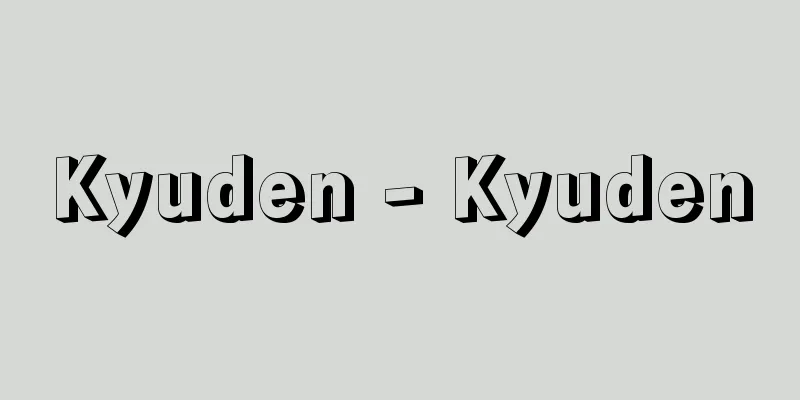Qin

|
It was one of the principalities of the Zhou Dynasty in China, and later became China's first unified dynasty (?-207 BC). [Takashi Yoshinami] Qin as a princely state in the Zhou dynastyThe transitional period from myths and legends to historical facts is thought to be around the time when records of Feizi were written. King Xiao of Zhou had Feizi raise livestock in Daqiu, gave him land in Qin, and gave him the name Ying. Duke Xiang was the first to be appointed as a feudal lord after he helped King Ping during the Zhou civil war, and was given land west of Qishan (northeast of Qishan County, Shaanxi Province) and made him Duke of Qin (771 BC). At this time, sacrifices were used to worship the Supreme Di, which originated from the customs of the Xirong. During the reign of Duke Wen, the capital was moved to the area where the Wei River and the Wei River meet, and the "crimes of the three clans" were decided. This law holds that when a person commits a crime, parents, wives, children, and siblings are also held responsible. It shows the expansion of sovereignty, and also serves as a legalization of the customs of the Rong and Di. In the second year of the reign of Duke Ning (714 BC), the capital was moved to Pingyang (southwest of Fengxiang County, Shaanxi Province). Later, in the 10th year of the reign of Duke Wu (688 BC), the Rong of Zui and Ji were defeated and a county was established there for the first time, with Du and Zheng designated as counties. During the reign of Duke De, the capital was set in Yong (Fengxiang County, Shaanxi Province), but during the reign of Duke Mu, the power of the Qin Dynasty increased dramatically. Duke Mu appointed Baili Xi and You Yu to the posts of Qin, showing them the way forward. Baili Xi was originally a nobleman of Yu, and was invited by Duke Mu to become his vassal. You Yu was a man of Jin, but was subordinate to King Rong at the time, and was subjugated by strategy. This policy of using guest ministers to strengthen the monarch's leadership became a Qin tradition. Youyu urged Duke Mu to reject the Code of Rites and Music and model his society after the Rongdi society, where the upper and lower classes were united. This was a way to reduce the influence of clans and aristocrats that inhibited sovereignty. As a result, Qin grew powerful, occupied the Hexi region, and conquered the Xirong region, and its territory is said to have reached a scale of 1,000 li. When Duke Mu died, many people died to follow his lead, but this was because he had made a promise to his subjects during his lifetime. In other words, the ruler was criticized by Qin's gentlemen for treating his subordinates freely as private vassals, but this was also a sign of the expansion of sovereignty. [Takashi Yoshinami] Qin as one of the Seven Warring StatesAfter that, Qin had internal conflicts and was unable to develop eastward. However, in 403 BC, Jin was divided into Han, Wei, and Zhao, so Duke Xian moved the capital east to Liyang (east of Lintong County, Shaanxi Province) and planned a strategy to control the east. His son, Duke Xiaogong, was a feudal lord, but was looked down upon as a Rongdi and was not able to join the eastern alliance. He felt angry and wanted to strengthen his own country and show his strength to the eastern lords. He sought talent far and wide and tried to enrich his country and strengthen his military. Gongsun Yang (later Shang Yang), a nobleman of Wei, came to court from Wei and explained his theory to Duke Xiaogong in the order of the imperial way, the kingly way, and the hegemonic way. Duke Xiaogong did not use the first two because they were too roundabout, but Duke Xiaogong was impressed by the Way of Hegemony. Shang Yang believed that practicing the Way of Hegemony was the path to eventually becoming the Way of the Emperor (the rule of Yao). Selected by Duke Xiaogong, Shang Yang created a class-based society in which only those with titles were valued, with rewards and punishments at its core and awarding titles based on agricultural and combat achievements. He then implemented the 150 system, a system in which the neighboring community (small clan-like unit) of the Wujia was used to cooperate with the state. This system allowed the ruler to grasp the Wuji and suppress intermediate forces in order to expand patriarchal power. The Wuji were used as units to create the Ju, and on top of them the Township and County were established as administrative units. The county system, which later led to the county and county system, was first established by Shang Yang. He also established the Qianmo system, which was precipitated by the "Fun-i-fa" policy to create small families, and is thought to have been an east-west land division line established to organize the land of the children who had developed the fields, but there are various theories and no consensus yet. The Shang Yang Reforms were implemented in two stages, the first and second, but the second reform was implemented after the capital was moved to Xianyang. Xianyang remained the capital until the fall of the Qin dynasty. Duke Xiaogong used the national power strengthened by the reforms to launch an eastern expedition and recaptured the land of Hexi from Wei. As a result of this defeat, Wei was forced to move its capital from Anyu (Houuma, Shanxi Province) to Daliang (Kaifeng, Henan Province) (340 BC). This eastern expedition by Qin posed a great threat to the eastern countries. The famous compromises and countermeasures such as the alliances made by Su Qin and Zhang Yi were all foreign policies that were thought up mainly by Qin. After Duke Xiaogong's death, King Huiwen succeeded him in Qin, and executed Shang Yang, with whom he had never been on good terms, but he continued to follow the basic policy of expanding the sovereignty of the monarch. Then, rather than immediately claiming dominance over the Central Plains, in order to further strengthen the foundations of national power, they conquered Bashu (Sichuan Province) and took possession of Hanzhong, which was under the control of the Chu state (312 BC). Furthermore, during the reign of King Zhao, they crossed the Yangtze River to the south, and General Bai Qi captured the Chu capital of Ying (Jiangling County, Hubei Province). In the east, they annexed the Hedong region of Wei, and, using Fan Ju to make full use of a strategy of befriending distant countries and attacking nearby ones, they dealt a fatal blow to the state of Zhao at Changping (260 BC). King Zhao eventually destroyed the Western Zhou Dynasty, and the King of the Eastern Zhou Dynasty was then destroyed by King Zhuangxiang Zichu of Qin, thus bringing the Zhou Dynasty to a formal end (249 BC). [Takashi Yoshinami] The Emergence of Emperor Qin Shi Huang and the Unification of ChinaThe son of Prince Zhuangxiang of Chu was King Zheng of Qin. He ascended to the throne at a young age, so the empress dowager and Prime Minister Lu Buwei held political power. However, he executed the empress dowager's lover Lao (238 BC) and recommended her as empress dowager, which led to Lu Buwei being driven out of power, and King Zheng of Qin finally took personal control. After that, he appointed Li Si as Prime Minister, adopted legalist policies, and established an autocratic imperial power while suppressing the power of the imperial court and the aristocracy. During that time, he sent generals such as Wang Jian to conquer various countries. The Kingdom of Han fell in 230 BC, but the other five countries succumbed to the power of the Qin state one after another in the next 10 years. A unified power came to dominate all of China (221 BC). This was the Qin Empire. He called himself the First Emperor, hoping for the Qin Empire to last forever, and hoped for it to continue for all eternity. He appointed a Prime Minister, a Grand Marshal, and a Chief Censor to assist the emperor in both administrative and military affairs. The local government system was not feudal, but rather adopted the county and prefecture system that had existed since Shang Yang, dividing the country into 36 counties, with governors, wei, and supervisors in the counties and governors and chiefs in the counties, with military affairs entrusted to the county marshals. In order to centralize power throughout the country, measures were standardized for weights and measures, currency, and writing styles. It is said that he also collected weapons and melted them down to prevent rebellions, making them the "Jin people." He built the Great Wall to defend the Xiongnu in the north, and expanded his sphere of influence to southern China in the south and Korea in the east. He also placed emphasis on ideological control. The Burning of Books and Burying of Scholars is a well-known incident, in which all books except those on agriculture, medicine, and divination were burned. However, Confucian scriptures and other documents from the various schools of thought that had been kept in government offices were left intact. The main aim of the book burning was to suppress movements that criticized the policies of the Qin dynasty by having people take these privately and circulate them. It is important to note that the Burying of Scholars was a punishment of Taoist priests who had slandered the First Emperor and Confucian scholars associated with them, and was not a complete attempt to eliminate Confucianism. This magnificent empire was the first in Asia to have a large territory, and the name Qin spread far to the Western world. This may also be where the theory that the name China originated from Qin comes from. However, Qin's legalistic coercion inevitably caused opposition from the still powerful aristocrats and various classes of peasants based on small clans. Moreover, the labor required to build tombs and palaces to demonstrate the power of the emperor was enormous, and the burden was heavy on the common people. The second emperor, Hu Hai, also adopted a similar policy using Zhao Gao. Zhao Gao abolished the class system and attempted to strengthen the sovereign's power, but the contradiction with reality only intensified. Around this time, a peasant rebellion broke out, led by Chen Sheng and Wu Guang, and inspired the aristocrats and heroes to raise the flag of anti-Qin. Prince Ying, the successor of Hu Hai, surrendered to Liu Bang of the Han Dynasty, who was a subordinate of Xiang Yu, and presented the imperial seal of the state to him, and the Qin Empire was destroyed (207 BC). After unifying the world, the Qin Empire reigned for 15 years under three generations. [Takashi Yoshinami] "The History of China 2: The Qin and Han Empires" by Sadao Nishijima (1974, Kodansha) [References] | [Chronology] |©Shogakukan "> Qin (Ying clan) / Brief family tree ©Shogakukan "> Qin's territory Source: Shogakukan Encyclopedia Nipponica About Encyclopedia Nipponica Information | Legend |
|
中国、周代の侯国の一つで、のち中国最初の統一王朝(?~前207)。 [好並隆司] 周代の侯国としての秦神話伝説から歴史事実とみられる移行期は非子の記載のあるころとみられる。周の孝王は大丘にいた非子に牧畜をさせ、秦の地を与え、嬴(えい)氏を名のらせた。襄公(じょうこう)は周の内乱に際して平王を助けたので初めて諸侯に任じ、岐山(きざん)(陝西(せんせい)省岐山県北東)以西の地を与え秦公とした(前771)。このとき犠牲を用いて上帝を祀(まつ)ったが、これは西戎(せいじゅう)の習俗に由来する。文公のとき、渭水(いすい)と水(けんすい)の合流点あたりに都を移し「三族の罪」を決めた。人が罪を犯したとき父母、妻子、兄弟まで連座する法律である。君主権の伸長を示すとともに戎翟(じゅうてき)の慣習を法制化した面もある。寧公2年(前714)には都を平陽(陝西省鳳翔(ほうしょう)県南西)に移した。そののち武公10年(前688)に邽(けい)、冀(き)の戎を討伐し、ここに初めて県を置き、杜(と)、鄭(てい)を県としている。徳公のとき雍(よう)(陝西省鳳翔県)に都したが、繆公(穆公)(ぼくこう)のときに飛躍的にその勢力を強めた。繆公は百里奚(ひゃくりけい)や由余を登用し、秦の進むべき道を指し示した。百里奚はもと虞(ぐ)の大夫であり、繆公の招請によって臣下となった。由余は晋(しん)の人であるが、当時、戎王の下にいたのを策略をもって臣従させた。このように客臣を用いて君主の指導力を強める方針は秦の伝統となった。由余は礼楽法度(れいがくほうど)を退けて上下一体の戎翟の社会をモデルにするよう繆公に勧めている。君主権を抑制する宗族(そうぞく)や貴族の勢力を削減する道である。このなかで強大となった秦は河西の地を占め西戎の地を伐(う)ったので、その領土は方千里に達したという。繆公は死んだとき多くの殉死者を得たが、それは生前、臣下と約束していたからである。つまり、君主が部下を私臣として自由に扱うということで、秦の君子たちの非難を受けているが、これも君主権伸長の一標識である。 [好並隆司] 戦国七雄の一国としての秦秦はその後、国内で争いを起こし東方発展の力はなかった。しかし、紀元前403年、晋が韓(かん)、魏(ぎ)、趙(ちょう)に分裂したので、献公は櫟陽(やくよう)(陝西省臨潼(りんとう)県東)に都を東遷して、東方経略を図った。その子、孝公は、諸侯でありながら戎狄(じゅうてき)と蔑視(べっし)されて東方の会盟に加わることができなかったので憤りを感じ、自国を強化して東方諸侯に力を示そうと考えた。そこで広く人材を求め、富国強兵を実現しようとした。魏から衛の公族出身の公孫鞅(おう)(後の商鞅)が来朝して、帝王の道、王道、覇道という順序で孝公に自説を述べている。前二者は回りくどいという点で孝公は用いなかったが、覇道は孝公を感銘させた。商鞅は覇道を実行することがやがて帝王の道(尭(ぎょう)の統治)に至る道程と考えていた。孝公に抜擢(ばってき)された商鞅は信賞必罰を核として、農業、戦闘の成果を計って授爵し、有爵者だけが評価される身分制社会をつくりだした。そして隣=伍家(ごか)という共同体(小宗族的)単位を基礎として国家に協力するという体制を什伍(じゅうご)制として施行した。これは君主が「伍」を把握するもので、中間的勢力を抑制して家父長的権力の伸長を計るものであった。その「伍」を単位として「聚(じゅ)」がつくられ、その上に「郷」「県」が行政単位として成立する。後の郡県制につながる県制は商鞅によって初めて設定された。阡陌(せんぱく)制を開いたのも彼であるが、これは小型家族の創設政策である「分異法」によって析出され、野を開拓した子弟の土地を整理するために設けられた東西の土地区画線と考えられるが、諸説あってなお定説はない。商鞅変法は第一次、第二次と施行されるが、この第二次変法は都を咸陽(かんよう)に移してのち行われている。咸陽はそれ以後、秦の滅亡するまで首都であった。 孝公は変法で強力となった国力で東征を展開し、河西の地を魏から奪回した。魏はこの敗戦の結果、都を安邑(あんゆう)(山西省候馬(こうま))から大梁(たいりょう)(河南省開封)に移さざるをえなかった(前340)。この秦の東征は東方諸国に大きな脅威を与えた。蘇秦(そしん)、張儀(ちょうぎ)らの有名な合従連衡(がっしょうれんこう)などの妥協策や対抗策はすべて秦を中心に考えられた外交政策である。孝公の死後、秦では恵文王が継ぎ、もともと仲のよくなかった商鞅を誅殺(ちゅうさつ)するが、政策の基本である君主権の伸長という方針はこれを踏襲した。そして、ただちに中原(ちゅうげん)に覇を唱えるのでなく、なおいっそう国力の基礎を強固にするため、巴蜀(はしょく)(四川(しせん)省)を制圧し、楚(そ)に属していた漢中を領有した(前312)。さらに昭王の時代には揚子江(ようすこう)を南渡し、将軍白起(はくき)は楚の首都郢(えい)(湖北省江陵県)を陥落させた。東方では魏の河東地方を併合し、范雎(はんしょ)を用いて遠交近攻策を駆使しつつ、長平において趙国に致命的な打撃を与えた(前260)。昭王はやがて西周を滅ぼし、東周君も秦の荘襄王(そうじょうおう)子楚(しそ)によって滅ぼされ、周王朝はここに形式上も終焉(しゅうえん)した(前249)。 [好並隆司] 始皇帝の登場と中国統一荘襄王子楚の子が秦王政である。彼は年少で王位についたので、太后や丞相(じょうしょう)呂不韋(りょふい)らが政治権力を握っていた。しかし、太后の愛人、嫪(ろうあい)を誅(ちゅう)し(前238)、を太后に推薦したことによって呂不韋も政権の座から追放して、ついに秦王政が親政することになった。それ以後、彼は丞相に李斯(りし)を用い、法家主義的政策を採用して、宗室、貴族の勢力を抑制しつつ、専制的皇帝権力を樹立した。その間、王翦(おうせん)らの将軍を派遣して各国を征服し続けた。韓王国の滅びたのは前230年であるが、以後、10年間に他の5国も次々と秦国の力の前に屈服した。そして中国全土を統一の権力が制覇することとなった(前221)。これが秦帝国である。彼は秦帝国の永遠なることを希望して始皇帝と称し、万世に至らんと願った。彼は丞相、太尉(たいい)、御史大夫(ぎょしたいふ)を配置して、行政、軍事両面における皇帝の補佐役とした。地方統治形態は封建制でなく、商鞅以来の郡県制をとり、全国を36郡に分け、郡には守、尉、監を、県には令、長などを置き、軍事は県尉にゆだねられた。全国を集権化する必要上、度量衡、貨幣、文章書体などを一定にする措置がとられた。そして、反乱を防ぐため武器を集めて溶融し「金人」としたという。北は匈奴(きょうど)防衛のため長城を設け、南は華南、東は朝鮮までもその勢力範囲を伸長した。イデオロギー統制にも力を入れた。焚書坑儒(ふんしょこうじゅ)は著名な事件であるが、農芸、医薬、卜占(ぼくせん)などを除くすべての書籍を焼いたようにいわれている。しかし、官庁に保管していた儒家の経典など諸子百家の文献は残されていた。それらを私的にもち流布させることによって秦朝の諸政策を非難する動きを抑制するのが焚書のおもなねらいであった。坑儒も始皇帝を誹謗(ひぼう)した方士たちと、それに関連した儒者が処罰されたのであって、儒家の抹殺という徹底したものでなかったことは注意を払っておく必要があろう。 この壮大な帝国はアジア世界において最初の大規模な領域をもち、秦の名は遠く西方世界にまで伝播(でんぱ)された。支那(しな)(チャイナ)の名称の起源は秦(チン)にあるという説があったのもそこに由来するであろう。しかし、秦の法家的威圧は、なお強い勢力をもつ貴族や小宗族を基礎とする農民各層の反発を招かざるをえなかった。しかも、皇帝権力の威を示すための陵や宮殿の造築に要した労働力は莫大(ばくだい)なもので、負担は庶民に重くのしかかった。二世皇帝胡亥(こがい)も趙高(ちょうこう)を用いて同様の政策をとった。趙高は身分制を撤廃して君権強化を計っているが、現実との背反は激しくなるばかりであった。このころ、陳勝(ちんしょう)・呉広(ごこう)らの農民反乱が起こり、それに触発されて貴族、豪傑らも反秦の旗を翻した。胡亥の後継の公子嬰(しえい)が項羽(こうう)の部将であった漢の劉邦(りゅうほう)に降(くだ)り、伝国の玉璽(ぎょくじ)を捧呈(ほうてい)して秦帝国は滅んだ(前207)。天下統一後、3代15年の治世であった。 [好並隆司] 『西嶋定生著『中国の歴史2 秦漢帝国』(1974・講談社)』 [参照項目] | [年表] |©Shogakukan"> 秦(嬴氏)/略系図 ©Shogakukan"> 秦の版図 出典 小学館 日本大百科全書(ニッポニカ)日本大百科全書(ニッポニカ)について 情報 | 凡例 |
Recommend
ECC - English
Error-Correcting Code⇒Error-Correcting CodeEllipti...
Canis Major (English spelling)
Sirius, the alpha star, is the brightest star in t...
Secondary surveillance radar
...To extend the reach, they are usually installe...
Beckerella subcostata (English spelling)
…It is a seaweed of the red algae family Gelidiac...
N,N'-Salicylidene aminato cobalt(II)
... Common name for N , N' -ethylenebis(salic...
Continent - tairiku (English spelling) continent
Geographically, it refers to a vast area of lan...
So - Yes
A self-governing association of villages that dev...
Canvas difference - Canvas difference
…If the distance is greater than that, it is call...
Maceió (English spelling)
The capital of the state of Alagoas in northeaster...
Oxya chinensis (English spelling) Oxyachinensis
…[Tokuji Chiba]. … *Some of the terminology that ...
Miracle
…Danish film director. He is the greatest master ...
Historical magazine - Shigakuzasshi
A monthly specialist magazine on Japan's leadi...
Collegium Aureum
A German chamber ensemble known for performing wit...
Saccolabium
...The former was introduced to Europe in 1839, a...
Prince Yoshihisa
Year of death: October 28, 1895 (Meiji 28) Year of...








![Chinzei [town] - Chinzei](/upload/images/67cc39500fb01.webp)
